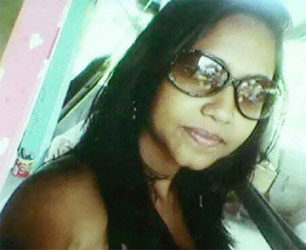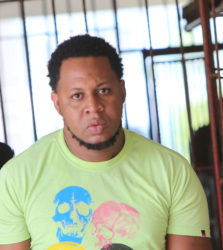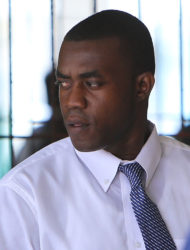A jury yesterday watched the video recording of Melroy Doris telling police that it was his co-accused Lennox Wayne, called `Two Colours’ who shot and killed beautician Ashmini Harriram at Lusignan in July, 2014.
The recording, which had been admitted into evidence at the trial of Doris and Wayne, was almost inaudible at times, while the video itself was to some extent blurry when it was presented to Justice Jo-Ann Barlow and the 12-member jury at the High Court in Georgetown.
Members of the jury had indicated that it was difficult to decipher what was being said between Melroy and the police conducting the interview. It was at this point that Justice Barlow made it clear that the court would no longer allow the video to be shown.

Prosecutor Tamieka Clarke, however, begged the court for a chance to have the recording played on equipment other than the projector belonging to the Supreme Court.
Police witness Carlson Rockcliffe, who recorded the interview at the Vigilance Police Station, told the court that both the audio and video were of good quality after he had viewed it.
The court staffer operating the equipment said there was nothing he could do to improve the quality of the audio or video, which had a number of loud background noises, including persons speaking and the honking of vehicle horns.
Defence attorney Nigel Hughes, who is representing Wayne, observed that the equipment through which the video was being played, did not have a built-in time counter. Counsel raised the concern that without this feature, replaying the video for cross-examination purposes would have been difficult.
Clarke, in an attempt, to ensure that the video was played, went on to suggest to the court that the lights be turned off in the room, to aid visibility. As the judge had observed, the surrounding natural light would have been too much to compete with.

It was, however, at this point that the defence extended a helping hand to the prosecution when Hughes allowed them to borrow his laptop computer, through which the video was played at a comparatively better quality.
The defence, which is contending that the police had doctored the video, specifically pressed Rockcliffe on how a building, which he agreed with Hughes was some 15 yards away from where the interview was done, ended up in the video.
The witness, who had explained that the interview was conducted in an enclosed room of the police station, was unable to explain to the defence how it was that the image of another building ended up in the video as seen by the court.
Asked what programme he used to do the recording and the brand of camera, Rockcliffe, a crime scene videographer, said he did not know.
Asked to explain the process of making copies of the tape from the original one, the witness, who visibly seemed to have been having trouble articulating himself, reduced his answer to “in the crime lab at CID, we have a something that we put the card reader in that come out the camera, and that would use to make the copy.”
Asked whether he had signed to uplifting the camera from the crime lab, and thereafter returning it, the videographer said no. Asked if he had made a written entry into any record keeping book at the station, the witness said he could not recall.

Rockcliffe agreed with Hughes that the video he had done was botched. He, however, remained adamant that the entire video heard by the court was the sum total of the interview conducted between Doris and the police.
He said it had the identical content as that of the original recording.
In a caution statement, which he does not deny giving to the police, Doris, a taxi driver, told the police that on the day in question, July 10, 2014, he was hired by Wayne, whom he referred to as `Two Colours.’
He said Wayne asked to be transported to Lusignan, East Coast Demerara, and after arriving in the area, they passed two girls at a corner and he requested that the vehicle stop.
According to Doris’ statement, which was read, after the vehicle came to a halt, `Two Colours’ whipped out a gun, exited the car, and shot one of the two girls.
It was Harriram, called “Munesha,” who was fatally shot.
After the shooting, Doris said, `Two Colours’ went back into the car, placed the gun to his head, and ordered him to drive.
Pathologist Dr. Nehaul Singh had testified that Harriram died of respiratory failure due to gunshot injuries to the spine.
He had explained that the bullet entered through her mouth, went under the base of her skull and exited through the back of her head, severing her spine in the process.
The case has been adjourned to April 24 at 10am for continuation.





